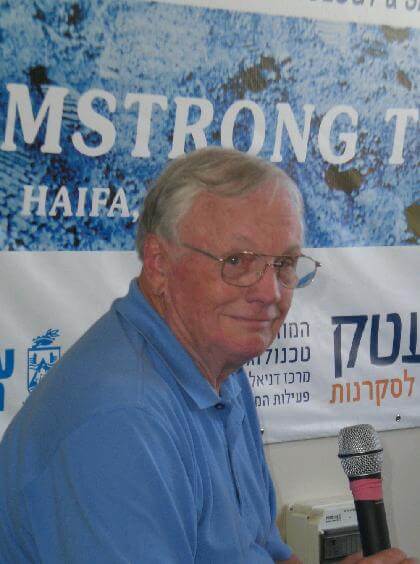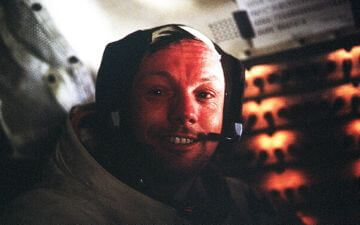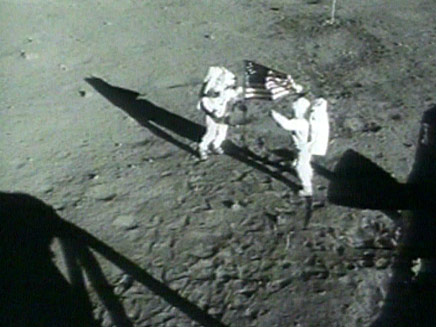Armstrong is humble, stayed away from interviews, and urged America and humanity in general to continue to explore and develop science

Neil Armstrong, the first man to walk on the moon, as commander of Apollo 11, died yesterday (25/8/2012) at the age of 82. from a complication after bypass surgery.
He was born in the small town of Wapakonta in Ohio on August 5, 1930. In a statement on behalf of the family it was stated: "Neil Armstrong was also a proud American who always believed that he was only doing the job that was required of him."
On July 20, 1969, about half a billion people - one-sixth of the human population at the time - watched blurry black-and-white images when astronaut Neil Armstrong descended the ladder of the Eagle lander, stuck his left foot on the lunar soil and said, "One small step A person is a big step for humanity."
20 minutes later, his teammate Buzz Aldrin joined him, and they spent two hours floating around lightly, taking soil samples, performing experiments, and taking the photographs that have become icons.
In the same topic on the science website:
- Neil Armstrong for children at the Science Museum in Haifa: Invest in science and math studies
- Neil Armstrong in Israel - those who don't take risks don't progress
- Apollo 11 - man on the moon. flight summary
- Michael Collins - The Apollo 11 astronauts worked hard but were not heroes
- NASA against the connection theory - we landed on the moon
It's fun, Armstrong then radioed Aldrin. The third crew member, Michael Collins hovered in orbit 100 kilometers above them in the command ship Columbia. President Richard Nixon called and said that the week of the journey is the greatest week in the history of the world since its creation."
In doing so, Armstrong fulfilled the vision of President Kennedy who announced immediately upon entering the White House that the US would send humans to the moon and return them safely to Earth before the end of the decade.
At the time of Kennedy's speech, Armstrong was a 30-year-old test pilot flying the X-15 rocket plane for a new government agency called NASA. He served as a pilot in the US Navy in the Korean War and participated in 78 combat missions. NASA has already had seven astronauts fly on Mercury spacecraft. In 1962 she expanded the team and Armstrong was one of nine to join.

On March 16, 1966, he became the first American citizen to orbit the Earth when he commanded the Gemini 8 mission in which David Scott also participated. In the fourth wave, they performed the first docking in space with another spacecraft, a maneuver designed to test the ability for the Apollo project to return the astronauts from the lunar surface to the spacecraft that will be waiting in orbit. Minutes later, the spaceship began spinning uncontrollably due to a malfunction in one of the maneuvering engines. It was a difficult moment, as the spacecraft spun around itself every second. Armstrong stopped the emergency by using a different series of rocket engines. According to the command of the control center they were required to land as soon as possible and indeed they did so by parachute ten hours later into the Pacific Ocean. The two were commended for keeping their cool, and when the Apollo project began, Armstrong was chosen to command one of the first six flights. NASA had a way of manning the astronauts - one served as backup for the mission and three others flew.
Armstrong, Aldrin and Fred Hayes were designated as the backup crew for Apollo 9 - the third spacecraft designed only to perform a lunar approach experiment. After that it was decided that it would be Apollo 8 in which astronauts would circle the moon. The mission was successful. Still in progress, lead astronaut Dick Slayton informed Armstrong that he and Aldrin would fly on Apollo 11.
In other words, luck made Armstrong one of the most famous names in the 21st century. If the order of the flights had changed or if Apollo 9 or 10 had gotten into trouble, Apollo 11 would not have been the first spacecraft to land on the moon.
Before the launch, Armstrong told reporters, "I believe we are going to the moon because it is human nature to face challenges."

On July 16, 1969, Armstrong, Collins, and Aldrin got up early, donned their spacesuits, and climbed aboard the Apollo 11 command ship on top of a Saturn 5 rocket. The launch went smoothly. Three days later they reached orbit around the moon and on the morning of July 20, Armstrong and Aldrin took their places on the seats of the landing craft - the Eagle, turned on the engines and dived towards the Sea of Tranquility, a flat plain near the lunar equator. As they approached, Armstrong sensed that they were in trouble, the Eagle computer brought them directly towards a crater with rocks the size of cars. Armstrong switched to manual control, fuel was in short supply, but he managed to hover several hundred meters above the surface in search of a safe landing area.
Aldrin then said that the computer alerted them to alert 1201, the computer was overloaded. Due to the lack of fuel, the two were almost ordered to cancel the landing and return to the command spacecraft.
In the end they landed on the last drops of fuel and Armstrong said the words "Houston, this is the calm base, the eagle has landed".
Armstrong later said that the landing was a much bigger challenge than walking on the moon. Eventually, after ensuring that the eagle was in good condition for the return flight, they began preparations for departure, which actually took place at 22:56 PM EST.
Armstrong walked on the moon for two hours and 21 minutes, Aldrin about half an hour less. They took rock samples, performed two experiments and spoke on the phone with President Nixon. They planted an American flag despite the problems, skipped in the low gravity of the moon, reported that it was fun, but it was difficult for them to stop.
Armstrong carried a camera on the chest of his space suit and took some of the famous pictures. Aldrin did not have a camera and therefore one of the ironies is that almost all of the stills were taken by Armstrong and he does not appear in them.
After a night's sleep, the two took off from the surface of the moon, joining Collins at Columbia. They parachuted safely into the Pacific Ocean on July 24, 1969 and then participated in parades and met with President Nixon. Armstrong then tried to return to private life. He worked for several years at NASA as the director of the Washington branch, taught engineering at the University of Cincinnati, not far from his birthplace. He also served as a director on corporate boards, participated in the commissions of inquiry into the Apollo 13 accident and the space shuttle Challenger disaster. He declined almost all requests for interviews and stopped signing autographs when he discovered that the recipients were selling them for thousands of dollars.
He suffered a minor heart attack in 1991, his wife Jan divorced him in 1994 and he remarried Carol Knight. In 2005, his authorized biographer James Hansen wrote, "Neil Armstrong today is a happy man, perhaps happier than at any other time in his life."
He didn't want to be an idol remembered only for the week-long trip in 1969. He appeared at the White House at major events commemorating Apollo 11 and used these rare opportunities to urge America to continue exploring.
"There are many more undiscovered ideas, breakthroughs available to those who can remove the protective layers of truth," he said in 1994.

8 תגובות
two abnaim
Where does it say that the spacecraft exploded?
Did Neil Armstrong's spaceship really explode?
It is better to use the word dead and not deceased
It is taken from an automatic external camera.
I have a pretty silly question.
Armstrong is photographed coming down the ladder - who took the picture?
Doesn't that mean he was actually the second man on the moon?
(and I have no doubt that we landed on the moon)